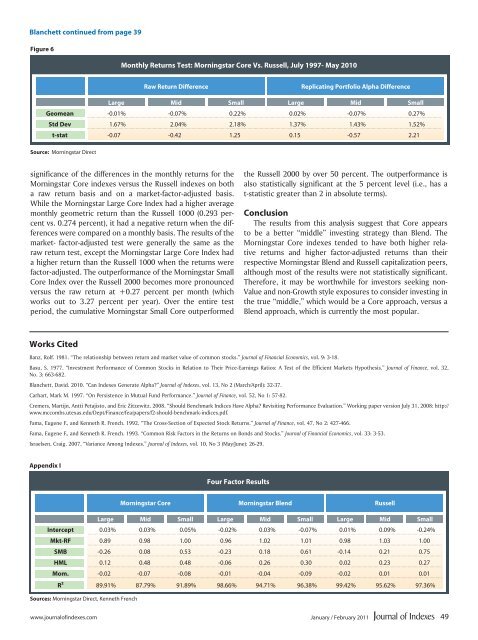Improved Beta? - IndexUniverse.com
Improved Beta? - IndexUniverse.com
Improved Beta? - IndexUniverse.com
You also want an ePaper? Increase the reach of your titles
YUMPU automatically turns print PDFs into web optimized ePapers that Google loves.
Blanchett continued from page 39<br />
Figure 6<br />
Monthly Returns Test: Morningstar Core Vs. Russell, July 1997- May 2010<br />
Raw Return Difference<br />
Replicating Portfolio Alpha Difference<br />
Large Mid Small Large Mid Small<br />
Geomean -0.01% -0.07% 0.22% 0.02% -0.07% 0.27%<br />
Std Dev 1.67% 2.04% 2.18% 1.37% 1.43% 1.52%<br />
t-stat -0.07 -0.42 1.25 0.15 -0.57 2.21<br />
Source: Morningstar Direct<br />
significance of the differences in the monthly returns for the<br />
Morningstar Core indexes versus the Russell indexes on both<br />
a raw return basis and on a market-factor-adjusted basis.<br />
While the Morningstar Large Core Index had a higher average<br />
monthly geometric return than the Russell 1000 (0.293 percent<br />
vs. 0.274 percent), it had a negative return when the differences<br />
were <strong>com</strong>pared on a monthly basis. The results of the<br />
market- factor-adjusted test were generally the same as the<br />
raw return test, except the Morningstar Large Core Index had<br />
a higher return than the Russell 1000 when the returns were<br />
factor-adjusted. The outperformance of the Morningstar Small<br />
Core Index over the Russell 2000 be<strong>com</strong>es more pronounced<br />
versus the raw return at +0.27 percent per month (which<br />
works out to 3.27 percent per year). Over the entire test<br />
period, the cumulative Morningstar Small Core outperformed<br />
the Russell 2000 by over 50 percent. The outperformance is<br />
also statistically significant at the 5 percent level (i.e., has a<br />
t-statistic greater than 2 in absolute terms).<br />
Conclusion<br />
The results from this analysis suggest that Core appears<br />
to be a better “middle” investing strategy than Blend. The<br />
Morningstar Core indexes tended to have both higher relative<br />
returns and higher factor-adjusted returns than their<br />
respective Morningstar Blend and Russell capitalization peers,<br />
although most of the results were not statistically significant.<br />
Therefore, it may be worthwhile for investors seeking non-<br />
Value and non-Growth style exposures to consider investing in<br />
the true “middle,” which would be a Core approach, versus a<br />
Blend approach, which is currently the most popular.<br />
Works Cited<br />
Banz, Rolf. 1981. “The relationship between return and market value of <strong>com</strong>mon stocks.” Journal of Financial Economics, vol. 9: 3-18.<br />
Basu, S. 1977. “Investment Performance of Common Stocks in Relation to Their Price-Earnings Ratios: A Test of the Efficient Markets Hypothesis.” Journal of Finance, vol. 32,<br />
No. 3: 663-682.<br />
Blanchett, David. 2010. “Can Indexes Generate Alpha?” Journal of Indexes, vol. 13, No 2 (March/April): 32-37.<br />
Carhart, Mark M. 1997. “On Persistence in Mutual Fund Performance.” Journal of Finance, vol. 52, No 1: 57-82.<br />
Cremers, Martijn, Antti Petajisto, and Eric Zitzewitz. 2008. “Should Benchmark Indices Have Alpha? Revisiting Performance Evaluation.” Working paper version July 31, 2008: http://<br />
www.mc<strong>com</strong>bs.utexas.edu/Dept/Finance/fea/papers/f2-should-benchmark-indices.pdf.<br />
Fama, Eugene F., and Kenneth R. French. 1992. “The Cross-Section of Expected Stock Returns.” Journal of Finance, vol. 47, No 2: 427-466.<br />
Fama, Eugene F., and Kenneth R. French. 1993. “Common Risk Factors in the Returns on Bonds and Stocks.” Journal of Financial Economics, vol. 33: 3-53.<br />
Israelsen, Craig. 2007. “Variance Among Indexes.” Journal of Indexes, vol. 10, No 3 (May/June): 26-29.<br />
Appendix I<br />
Four Factor Results<br />
Morningstar Core Morningstar Blend Russell<br />
Large Mid Small Large Mid Small Large Mid Small<br />
Intercept 0.03% 0.03% 0.05% -0.02% 0.03% -0.07% 0.01% 0.09% -0.24%<br />
Mkt-RF 0.89 0.98 1.00 0.96 1.02 1.01 0.98 1.03 1.00<br />
SMB -0.26 0.08 0.53 -0.23 0.18 0.61 -0.14 0.21 0.75<br />
HML 0.12 0.48 0.48 -0.06 0.26 0.30 0.02 0.23 0.27<br />
Mom. -0.02 -0.07 -0.08 -0.01 -0.04 -0.09 -0.02 0.01 0.01<br />
R² 89.91% 87.79% 91.89% 98.66% 94.71% 96.38% 99.42% 95.62% 97.36%<br />
Sources: Morningstar Direct, Kenneth French<br />
www.journalofindexes.<strong>com</strong> January / February 2011 49

















